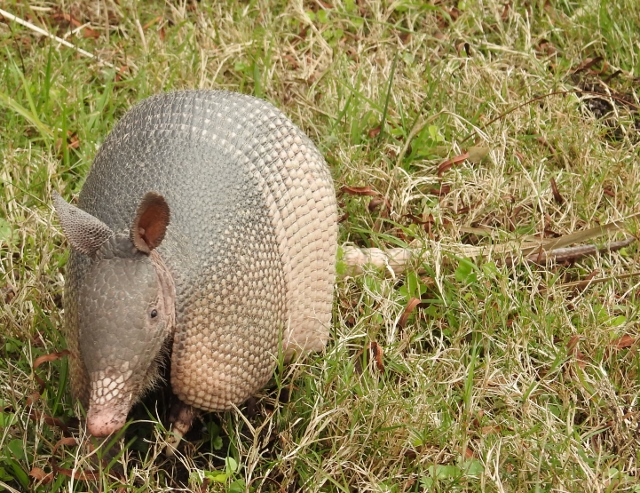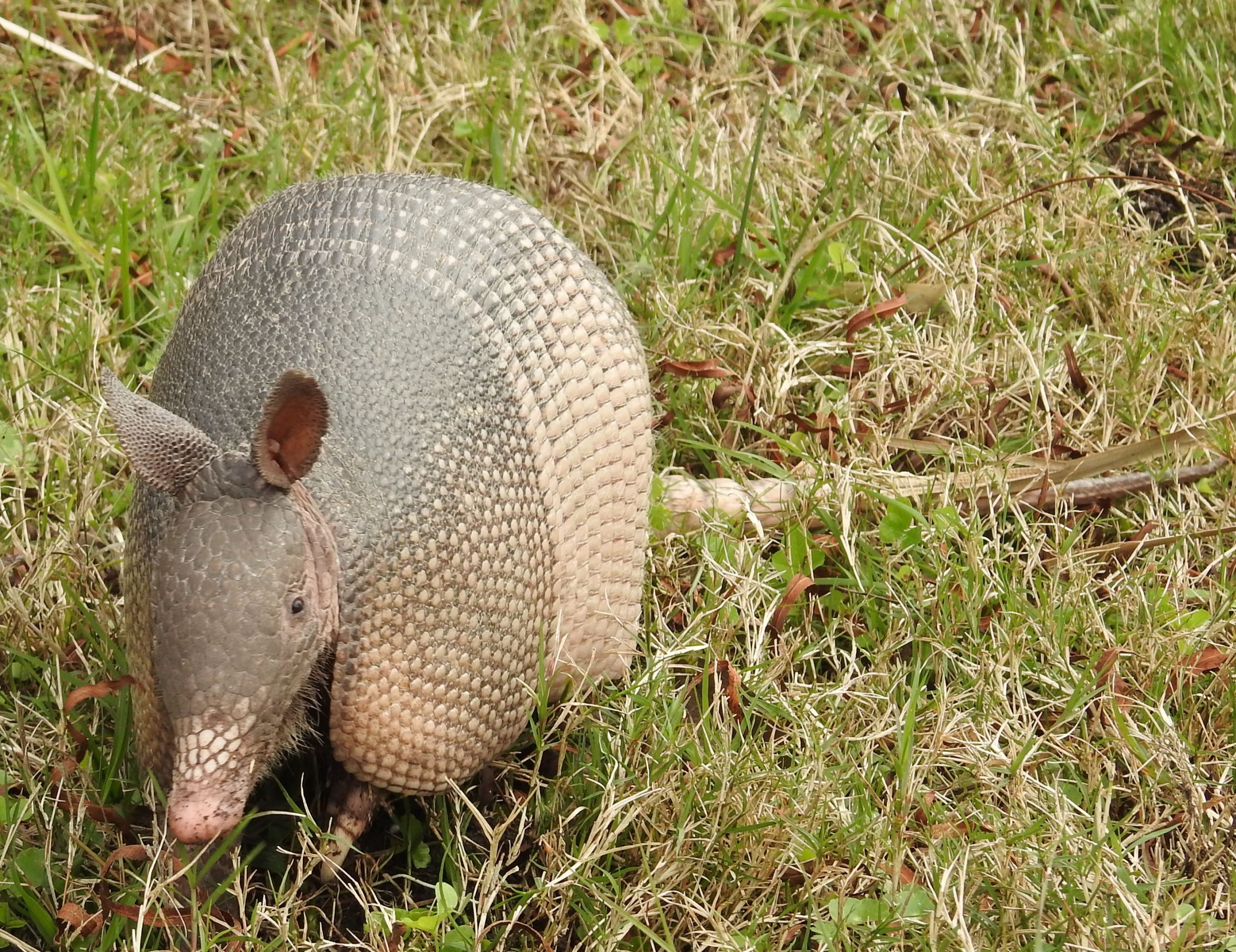—Texas’ official state small mammal
by M. Kathy Raines

Mirroring traits of the quintessential Texan, the nine-banded armadillo is “a hardy, pioneering creature,” one possessing “deep respect and need for the land, the ability to change and adapt, and a fierce, undying love for freedom,” according to 1995’s Texas legislature. Armadillos’ migration to Texas roughly coincides with Texas’ becoming a state, it noted.
Thus, this armadillo, with House Concurrent Resolution #178, became the state’s Official Small Mammal. It faced stiff competition with the Texas Longhorn, which won for large animal.
Many would heartily agree. We’re proud of these dauntless, armored little Texans rooting about for worms and insects. More often we see their signs, holes and hillocks of upturned soil, sometimes disrupting lovingly tended gardens. A good many Texans misname “Lonesome Homesick Blues” by Gary P. Nunn, “Home with the Armadillo Song” for its iconic line, “I want to go home with the armadillo…”
Unfortunately, with their popularity, the species has suffered from our insatiable appetite for the bizarre. Along with sensible uses—their leather creates boots, guitar straps, wallets and the lute-like South American charango—craftspeople fashion their shells into armadillo hats and lamps. One taxidermist offers a stuffed, beer-guzzling armadillo lying on its back for $299.95.
Texans once called armadillos “Hoover’s hogs” for their use as “poor man’s pork” during the Great Depression. Some call them “dillers,” “rhino pigs” or even the cruel moniker “Texas speed bumps;” they are often crushed under wheels. “Armadillo” means “little armored one” in Spanish.
The nine-banded armadillo (Dasypus novemcinctus) joins anteaters, tree sloths and its 19 fellow armadillos in the superorder Xenarthra, a name combining Latin ‘xeno’ for strange and Greek ‘arthron’ for ‘joint.’ Armadillos are the only surviving creatures in the order Cingulata, whose name is Latin for ‘girdled’ or ‘belted’. Both their family and genus names, Dasypodida and Dasypus, are Greek and Latin combinations meaning “hairy foot;” botanist Carl Linnaeus, likely meant it to translate “rough-footed.” “Novemcinctus,” its species name, is Latin for “nine-banded.”
Looking like a beautifully tiled floor, the nine-banded armadillo’s carapace, made of modified skin, consists of tough but pliable overlapping plates, separated by seven to eleven bands, that shield its shoulders and rump. Its tapered tail is coated with what look like bony teeth. It has only scattered hairs, and far back in its jaws sit about 30 small molars.
This armadillo’s underside is soft and vulnerable. However, confronted by a coyote, which can bite through its plates, the armadillo may flip over and fight viciously with its razor-sharp claws. If a predator has chased it partway inside its burrow, the armadillo may shove it against the wall. Also, with its low, tank-like body, an armadillo can escape by slipping through thorny brush. It also runs, dodges or climbs. It does not curl into a ball—that’s the Brazilian three-banded armadillo.
This creature eats rather constantly, foraging in early mornings or evenings on hot days and during afternoons when it’s cooler. It grunts, raises its snout, sniffs the air and digs cone-shaped holes a few inches deep, probing for insects and worms which adhere to its long, sticky tongue. An examination of 800 armadillo bellies revealed 488 types of food, 93 percent of it animal matter, including 28 percent larval and adult scarab beetles—which devastate crops—14 percent termites and ants, 8 percent caterpillars, along with earthworms, centipedes, millipedes, crayfish and scant reptiles, amphibians and plants.
Armadillos do not, as alleged, raid chicken and turkey nests; eggs make up a tiny portion of their diet. Nor do they dig up corpses as some, calling them “gravediggers,” have claimed.
This armadillo, which thrives in various habitats in South America upwards throughout our Southeast, is expanding northwards. However, being a non-hibernator that bears little hair and lacks insulating fat, it cannot tolerate freezing temperatures. To flourish, it requires soil sufficiently soft for foraging and burrowing. Also, since its carapace quickly absorbs heat, it needs shade. Armadillos like living near streams.
These usually solitary creatures appear to pair off during breeding season, usually around July. They prepare a breeding burrow, a dome-shaped chamber containing a loose grassy, leafy nest, which they sometimes share.
The female, with her bony carapace, mates lying on her back. The fertilized ovum, forming a blastocyst, enters the uterus in a few days but does not implant itself for about fourteen weeks, presumably to prevent pups from arriving during cold weather.
Identical quadruplets usually appear in March, wearing soft skin that eventually hardens. Rancho Viejo residents have already reported seeing them. Pups walk in a few hours, forage with the mother in a few weeks and are weaned in two months. They themselves mate in about sixteen months.
Armadillos, which have poor eyesight, often root nonchalantly as people stand nearby snapping photos. A panicked armadillo, though, may rear up on its hind legs—sometimes smashing itself into the underside of a car that might otherwise have passed right over it.
When an armadillo must cross a stream, it gulps air, inflating itself, enhancing both lung capacity and buoyancy. Able to hold its breath for six minutes, it alternately dogpaddles and walks underwater, apparently preferring the latter. An armadillo also enjoys mud baths.
As it rambles along, one armadillo will create or, in rocky, hilly areas, find, several burrows, ones that can conveniently be reused by skunks, mice and snakes. Some dens also make handy traps for refuge-seeking invertebrates.
Armadillos are flourishing in spite of auto accidents and humans trapping and shooting them. Some relish their meat for chili and barbecue.
Researchers prize armadillos both because they have broods of identical siblings and because they—the only known non-humans to do so— host and pass on the delicate and slow-growing bacteria that causes Hansen’s disease, or leprosy. This disease, if untreated, damages nerves, thus leading to paralysis, blindness and crippling of limbs. Thus, Texas prohibits the sale of live armadillos.
Armadillos didn’t start this. It was we who carried leprosy to the New World. Scientists suspect it is an armadillo’s cool body temperature, about 90 degrees, that allows the bacteria to flourish.
The good news is that 95 percent of us are naturally immune to leprosy, and annually, fewer than 250 Americans contract the disease. Those still wishing to dine on armadillo meat should wear gloves when dressing it and cook the meat well.

